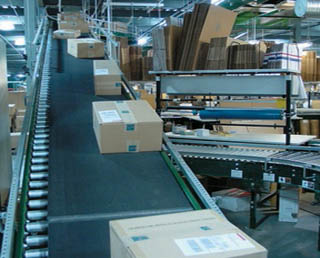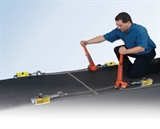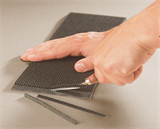Industry Spotlight: Best Practices for Safe and Efficient Belt Repair in Packaging
 There’s no getting around it – belts fail. It’s a part of working with conveyors; all belts wear over time and can fail prematurely due to a multitude of reasons. And conveyor downtime during critical sortation events can cost hundreds, or even thousands of dollars per minute in the packaging industry.
There’s no getting around it – belts fail. It’s a part of working with conveyors; all belts wear over time and can fail prematurely due to a multitude of reasons. And conveyor downtime during critical sortation events can cost hundreds, or even thousands of dollars per minute in the packaging industry.
The light at the end of that “downtime tunnel” is that replacing the belt and installing the splice correctly, and with the right tools, will undoubtedly reduce periods of unexpected downtime. That’s why we’re here to discuss what you should (and shouldn’t do) when installing mechanical belt fasteners.
The cause
You may be surprised to know that the main cause of splice failure does not involve the strength or endurance of your mechanical fastener. In fact, the main cause of failure is faulty installation practices, including:
- Fasteners not being installed into the belt properly. The fasteners are “under-clinched” and not clinched deeply enough into the belt. While you don’t want to ruin the integrity of the belt carcass, you do need to get the fasteners in deep enough to hold. And any high spots created by an under-clinched fastener increase the rate at which the metal fastener will wear.
- Fasteners installed into un-squared belt ends. Not taking the time to square your belt properly can cause tracking issues on your belt, which will fray the edges of the splice, drive the splice into the conveyor structure, and cause it to fail prematurely.
- Prominent impression cover patterns not properly skived or not skived at all. When rough top, wedge grip, and other covers with grooves or impressions in them aren’t skived, the grip on the belt is uneven and the splice will fail more quickly than if it were skived.
The effect
We already know the effect of failed splices … downtime, missed deadlines, lost revenues. Conveyor belt splice longevity is critical to the overall output of most package distribution systems. So it’s important to take steps to help prevent premature splice failure, and to safely and efficiently splice your belt when it does happen.
The solution
I kind of showed my hand earlier by eluding to the solution … proper installation and the right tools are the key to strong splices. We’ll start with a few tips to prepare for proper installation of your belt splices. These steps will not only help ensure that strong, quality splice, but will also help keep your maintenance team safe.
 Clamp the belt. Serious injuries are possible when clamping is done without using the proper tools and products. The best belt clamps provide a safe, repeatable, and controlled amount of pressure on the belt, making them safer to work with and making proper splice installation easier. Flexco SmartClamp™ Belt Clamps ensure clamping pressure is evenly distributed at each clamp, keeping belt integrity intact and maintenance hazards at a minimum.
Clamp the belt. Serious injuries are possible when clamping is done without using the proper tools and products. The best belt clamps provide a safe, repeatable, and controlled amount of pressure on the belt, making them safer to work with and making proper splice installation easier. Flexco SmartClamp™ Belt Clamps ensure clamping pressure is evenly distributed at each clamp, keeping belt integrity intact and maintenance hazards at a minimum.
 Square the belt. An accurate, squared cut will enhance belt and splice performance and discourage mistracking, which can occur when a cut is made on an angle. A Laser Belt Square makes the process of squaring a belt for splicing fast, easy, and accurate. While the utility knife is an attractive option for cutting the belt because it is readily available and inexpensive, it can be a safety and accuracy nightmare. Consider a tool like the Flexco 845LD Belt Cutter, which produces a straight cut every time. Plus it has an enclosed blade, which is a big safety advantage as any exposed blades are inherently dangerous.
Square the belt. An accurate, squared cut will enhance belt and splice performance and discourage mistracking, which can occur when a cut is made on an angle. A Laser Belt Square makes the process of squaring a belt for splicing fast, easy, and accurate. While the utility knife is an attractive option for cutting the belt because it is readily available and inexpensive, it can be a safety and accuracy nightmare. Consider a tool like the Flexco 845LD Belt Cutter, which produces a straight cut every time. Plus it has an enclosed blade, which is a big safety advantage as any exposed blades are inherently dangerous.
 Skive the belt. Removing impression covers is paramount in achieving a quality mechanical belt splice. Skiving the impression cover down to the skim coat allows the fasteners to seat into a flat surface, ensuring a strong and even clinch. On flat belts where there is ample top cover, skiving the belt can sometimes reduce the splice profile for better interaction with belt cleaners and the rest of the conveyor system.
Skive the belt. Removing impression covers is paramount in achieving a quality mechanical belt splice. Skiving the impression cover down to the skim coat allows the fasteners to seat into a flat surface, ensuring a strong and even clinch. On flat belts where there is ample top cover, skiving the belt can sometimes reduce the splice profile for better interaction with belt cleaners and the rest of the conveyor system.
When it comes to installing your fasteners, here are a few things to keep in mind:
Choose the right fastener. Depending on the type of belt you are running and the materials you are conveying, you’ll want to make sure you are choosing the correct fasteners for the job. Matching the fastener to the application helps ensure a strong, long-lasting splice. This can help lessen the chance of sudden failures that can put workers at risk. When choosing fasteners for a skived belt, make sure you are basing your measurements off the skived dimension for the best possible fit.
Choose the best and most efficient belt splicing tool. If we’re talking about getting the job done safely and quickly, you will want to choose the best and most efficient belt splicing tools to create the highest quality finished belt splices quicker than regular hammer installation. For example, if your choice of fastener is the Clipper® Wire Hook Fastening System, then the Roller Lacer® Gold Class™ with the option of driving the head with a cordless drill, will gently and precisely roll your hooks into the belt for a low-profile splice in half the time and with less effort.
Your best tool … proactive maintenance
It is important to remember that the most important tools you have in your arsenal are your own eyes. Walking the line to take stock of the health of your splices and other equipment and then planning proactive maintenance is your best plan of action. And when it comes time to install those splices, know that you can always take advantage of Flexco’s experience and expertise in belt splicing. Talk to your local Flexco representative or sign up for free on-site training here.
Authored By: Todd Stewart, Industry Manager
Stewart has been with Flexco for almost 30 years, working in various roles from customer service, to manufacturing, to training and new product development. As Industry Manager, Stewart thoroughly researches target industries, creating programs to support each industry and identifying customer issues, as well as potential product solutions. Stewart currently leads the development of the Parcel Handling Industry Program and is responsible for ensuring that Flexco is positioned to serve the needs of our global customers. Stewart earned a bachelor’s degree in Marketing with a B2B specialty from Davenport University.
Subscribe to the Flexco Blog
Published Date
February 05, 2020Product Groups
- Belt Maintenance Tools
- Mechanical Belt Fastening Systems
Industries
- Parcel Handling
- Warehousing and Distribution
Issues
- Belt Damage
- Belt Wear
- Downtime
- Maintenance
